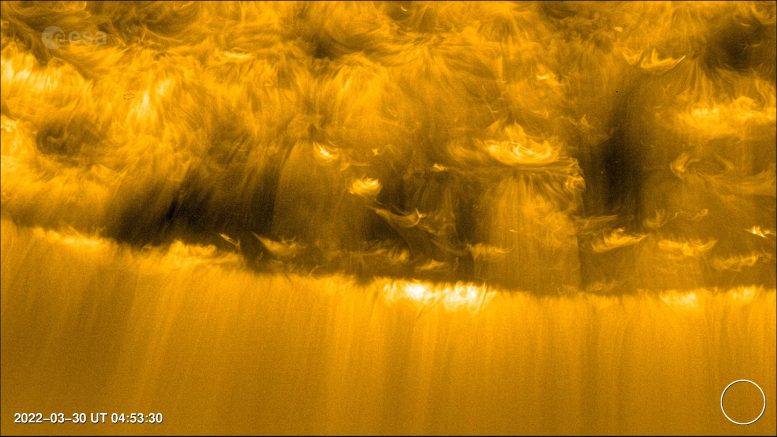
The Solar Orbiter discovered tiny jets from the Sun, potentially explaining the solar wind’s origin. This challenges traditional beliefs about the wind’s generation, with the new data suggesting an intermittent outflow. The findings could also have implications for understanding other stars’ atmospheres. Credit: ESA & NASA/Solar Orbiter/EUI Team; acknowledgment: Lakshmi Pradeep Chitta, Max Planck Institute for Solar System Research
The ESA/NASA Solar Orbiter spacecraft has discovered a multitude of tiny jets of material escaping from the Sun’s outer atmosphere. Each jet lasts between 20 and 100 seconds, and expels plasma at around 100 km/s (60 miles/s) or 360,000 km/h (220,000 mph). These jets could be the long-sought-after source of the solar wind.
Understanding the Solar Wind
The solar wind is composed of charged particles, known as plasma, that continuously escape the Sun. It propagates outwards through interplanetary space, colliding with anything in its path. When the solar wind collides with Earth’s magnetic field, it produces the aurorae.
Although the solar wind is a fundamental feature of the Sun, understanding how and where it is generated near the Sun has proven elusive and has been a key focus of study for decades. Now, thanks to its superior instrumentation, Solar Orbiter has taken us an important step closer.
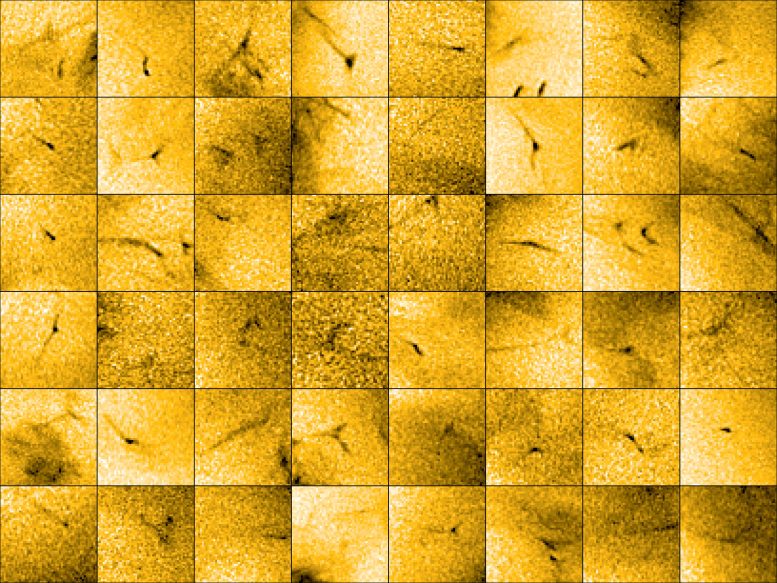
This mosaic of images shows a multitude of tiny jets of material escaping from the Sun’s outer atmosphere. The images come from the ESA/NASA Solar Orbiter spacecraft. They show up as dark streaks across the solar surface in this mosaic. The images are ‘negatives’ meaning that although the jets are displayed as dark, they are bright flashes against the solar surface. Credit: ESA & NASA/Solar Orbiter/EUI Team; acknowledgment: Lakshmi Pradeep Chitta, Max Planck Institute for Solar System Research, CC BY-SA 3.0 IGO
High-resolution Imaging of the Sun’s Surface
The data comes from Solar Orbiter’s Extreme Ultraviolet Imager (EUI) instrument. Images of the Sun’s south pole taken by EUI on March 30, 2022, reveal a population of faint, short-lived features that are associated with small jets of plasma being ejected from the Sun’s atmosphere.
“We could only detect these tiny jets because of the unprecedented high-resolution, high-cadence images produced by EUI,” says Lakshmi Pradeep Chitta, Max Planck Institute for Solar System Research, Germany, and the principal author on the paper describing this work. In particular, the images were taken in the extreme ultraviolet channel of EUI’s high resolution imager, which observes million-degree solar plasma at a wavelength of 17.4 nanometers.
Of particular importance is the fact that analysis shows that these features are caused by the expulsion of plasma from the solar atmosphere.
This movie was created from observations taken by the ESA/NASA Solar Orbiter spacecraft on March 30, 2022, between 04:30 and 04:55 UTC, and was previously released last year. It shows a ‘coronal hole’ near the Sun’s south pole. Subsequent analysis revealed many tiny jets being released during the observation. They show up as little flashes of bright light across the image. Each one expels charged particles, known as plasma, into space. The circle indicates the size of the Earth for scale. Credit: ESA & NASA/Solar Orbiter/EUI Team; acknowledgment: Lakshmi Pradeep Chitta, Max Planck Institute for Solar System Research
Magnetic Structures and the Solar Wind
Researchers have known for decades that a significant fraction of the solar wind is associated with magnetic structures called coronal holes – regions where the Sun’s magnetic field does not turn back down into the Sun. Instead, the magnetic field stretches deep into the Solar System.
Plasma can flow along these ‘open’ magnetic field lines, heading into the Solar System, creating the solar wind. But the question was: how did the plasma get launched?
The traditional assumption was that because the corona is hot, it will naturally expand and a portion of it will escape along the field lines. But these new results look into the coronal hole that was situated at the Sun’s south pole, and the individual jets that were revealed challenge the assumption that the solar wind is produced only in a steady continuous flow.
“One of the results here is that to a large extent, this flow is not actually uniform, the ubiquity of the jets suggests that the solar wind from coronal holes might originate as a highly intermittent outflow,” says Andrei Zhukov, Royal Observatory of Belgium, a collaborator on the work who led the Solar Orbiter observing campaign.
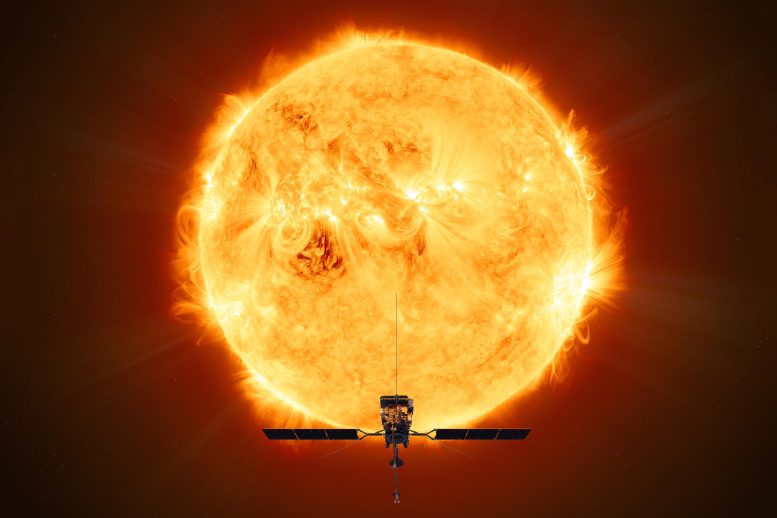
ESA’s Solar Orbiter mission will face the Sun from within the orbit of Mercury at its closest approach. Credit: ESA/ATG medialab
Energy Analysis of the Jets
The energy associated with each individual jet is small. At the top end of coronal phenomena are the X-class solar flares, and at the lower end are the so-called nanoflares. There is a billion times more energy in an X-flare than in a nanoflare. The tiny jets discovered by Solar Orbiter are even less energetic than that, manifesting around a thousand times less energy than a nanoflare, and channelling most of that energy into the expulsion of the plasma.
The ubiquity of them implied by the new observations suggests that they are expelling a substantial fraction of the material we see in the solar wind. And there could be even smaller, more frequent events providing yet more.
“I think it’s a significant step to find something on the disc that certainly is contributing to the solar wind,” says David Berghmans, Royal Observatory of Belgium, and principal investigator for the EUI instrument.
Future Observations and Broader Implications
Currently, Solar Orbiter is still circling the Sun close to its equator. So in these observations, EUI is looking across the south pole at a grazing angle.
“It’s harder to measure some of the properties of these tiny jets when seeing them edge-on, but in a few years, we will see them from a different perspective than any other telescopes or observatories so that together should help a lot,” says Daniel Müller, ESA Project Scientist for Solar Orbiter.
That is because as the mission continues, the spacecraft will gradually incline its orbit towards the polar regions. At the same time, the activity on the Sun will progress through the solar cycle and the coronal holes will begin popping up at many different latitudes, providing a unique new perspective.
All involved will be eager to see what fresh insights they can collect because this work extends further than our own Solar System.
The Sun is the only star whose atmosphere we can observe in such detail, but it is likely that the same process operates on other stars too. That turns these observations into the discovery of a fundamental astrophysical process.
Reference: “Picoflare jets power the solar wind emerging from a coronal hole on the Sun” by L. P. Chitta, A. N. Zhukov, D. Berghmans, H. Peter, S. Parenti, S. Mandal, R. Aznar Cuadrado, U. Schühle, L. Teriaca, F. Auchère, K. Barczynski, É. Buchlin, L. Harra, E. Kraaikamp, D. M. Long, L. Rodriguez, C. Schwanitz, P. J. Smith, C. Verbeeck and D. B. Seaton, 24 August 2023, Science.
DOI: 10.1126/science.ade5801
Solar Orbiter is a space mission of international collaboration between ESA and NASA, operated by ESA.

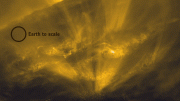
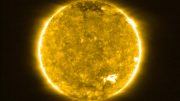
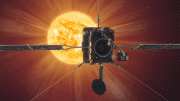
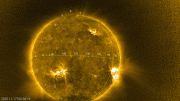
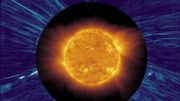
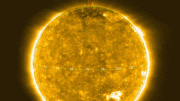

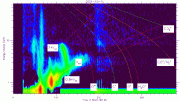
Be the first to comment on "Solar Orbiter Spacecraft Discovers Tiny Jets That Could Power the Solar Wind"